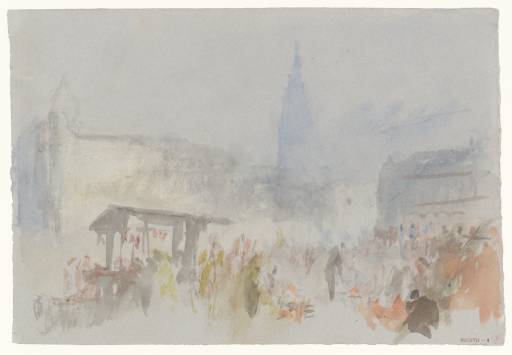Joseph Mallord William Turner The Market Place, Coburg 1840
Joseph Mallord William Turner,
The Market Place, Coburg
1840
Joseph Mallord William Turner 1775–1851
The Market Place, Coburg 1840
D32187
Turner Bequest CCCXVII 8
Turner Bequest CCCXVII 8
Watercolour and gouache on grey wove paper, 192 x 279 mm
Blind-stamped with Turner Bequest monogram towards bottom right
Stamped in black ‘CCCXVII – 8’ bottom right
Blind-stamped with Turner Bequest monogram towards bottom right
Stamped in black ‘CCCXVII – 8’ bottom right
Accepted by the nation as part of the Turner Bequest 1856
Exhibition history
1995
Turner in Germany, Tate Gallery, London, May–September 1995, Städtische Kunsthalle Mannheim, September 1995–January 1996, Hamburger Kunsthalle, Hamburg, January–March 1996 (99, as ‘The Market Place at Coburg’, 1840, reproduced in colour).
References
1909
A.J. Finberg, A Complete Inventory of the Drawings of the Turner Bequest, London 1909, vol.II, p.1022, CCCXVII 8, as ‘Market place’.
1930
A.J. Finberg, In Venice with Turner, London 1930, p.175, as possible Tyrol subject.
1995
Cecilia Powell, Turner in Germany, exhibition catalogue, Tate Gallery, London 1995, pp.81 note 2, 145 under no.67, 154 under no.79, 169 under no.98, 169–70 no.99, as ‘The Market Place at Coburg’, 1840, reproduced in colour.
1997
Inge Herold, Turner on Tour, Munich and New York 1997, reproduced in colour p.104, as ‘The Marketplace in Coburg’, pp.106, 108.
2001
Cecilia Powell, ‘Coburg’ in Evelyn Joll, Martin Butlin and Luke Herrmann eds., The Oxford Companion to J.M.W. Turner, Oxford 2001, p.50.
Turner was in Coburg, then capital of the German Duchy of Saxe-Coburg-Gotha, between 17 and 20 September 1840, and made many pencil drawings of the town and its surroundings in the Venice; Passau to Würzburg sketchbook; see under Tate D31278 (Turner Bequest CCCX 1a). Cecilia Powell identified the present colour study, comparing it with one of the small pencil sketches on D31278 and describing the scene:
In this view from the west, Coburg’s town hall is on the right and the Stadthaus, another municipal building ... on the left, while the dark spire of St Moritz can be seen towering over the east side of the square. All these are shown very impressionistically, though Turner has clearly indicated the historic oriels which project at the corners of both municipal buildings and has emphasised the horizontal divisions which are such a prominent feature of the eighteenth-century façade of the town hall.1
Powell further observed that ‘the square itself is teeming with activity’, with figures ‘clustered around fires, evidently cooking bratwurst in exactly the same spot as is used today for this very purpose.’2
This is one of four colour studies on grey paper around Coburg, which can all be related to Venice; Passau to Würzburg pencil sketches (see also Tate D32186, D32188 and D32190; Turner Bequest CCCXVII 7, 9, 11); there are additionally three loose watercolours on conventional white sheets (D35889, D35948, D36187; CCCLXIV 49, 105, 329).3 Inge Herold has also described this as among ‘the freest and most impressionistic’ of such studies: ‘In combination with the grey paper the subdued, delicate colors produce a hazy, misty mood like that of an early fall morning.’4
Originally described as simply showing a ‘Market place’,5 this sheet had nevertheless been included in the ‘Venice: Miscellaneous. (b) Grey Paper’ section of Finberg’s 1909 Inventory, albeit among a handful (Tate D32185–D32191; Turner Bequest CCCXVII 6–12) of which he noted ‘some – probably all ... are not Venetian subjects’, but likely ‘done at the same time, and may therefore help to throw light on Turner’s movements.’6 In 1930 he noted that ‘some ... may have been made in the Tyrol on the way to or from Venice’.7 Other than D32189, a view of Bolzano (Bozen) from the outward leg, and D32191, which may show the Venetian Lagoon, they have all since been identified as German subjects from 1840’s return journey, and are included in this subsection (see also the technical notes).
Technical notes:
Among many such works on the blue or grey papers customarily used by Turner, this is one of five originally from a single piece (Tate D32186–D32188, D32190, D36158; Turner Bequest CCCXVII 7–9, 11; CCCLXIV 301) to be identified by Cecilia Powell as showing Coburg and Würzburg subjects.1 They are neatly torn eighths of a sheet of grey Bally, Ellen and Steart paper, likely made in 18292 (albeit none of these sections bears a watermark), of the type often used in 1840 (see the Introduction to the overall tour).3
Noting Finberg’s provisional mingling of then unidentified German views with Venice subjects in the 1909 Inventory, as discussed above, Powell concurred that ‘there are, indeed, strong resemblances of both palette and expression between the four Coburg [and single Würzburg] drawings and the much larger Venetian group’, and suggested that the other three eights of the sheet had likely been used in Venice,4 although this possibility was not addressed specifically in Ian Warrell’s subsequent checklist of the Bally, Ellen and Steart sheets Turner used there.5
See also Peter Bower, Turner’s Later Papers: A Study of the Manufacture, Selection and Use of his Drawing Papers 1820–1851, exhibition catalogue, Tate Gallery, pp.105, 107, for discussion of another such group, comprising seven Regensburg and Walhalla views included in the present subsection.
Verso:
Blank; inscribed in pencil ‘CCCXVII.8’ bottom right; stamped in black ‘CCCXVII – 8’ bottom right.
Matthew Imms
September 2018
How to cite
Matthew Imms, ‘The Market Place, Coburg 1840 by Joseph Mallord William Turner’, catalogue entry, September 2018, in David Blayney Brown (ed.), J.M.W. Turner: Sketchbooks, Drawings and Watercolours, Tate Research Publication, December 2019, https://www

